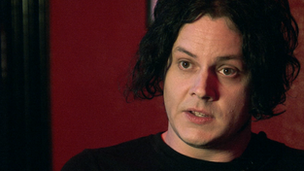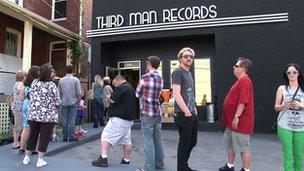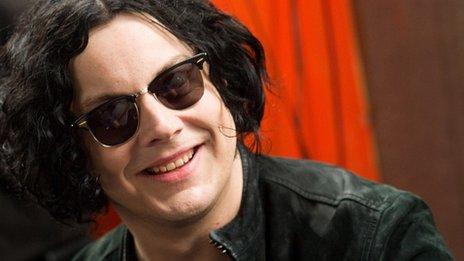Jack White's meaningful style
- Published
- comments
Jack White on the romance of vinyl
For a man who can pump out such blistering, no-nonsense post-punk hard rock, the air of the more mannered art-school rocker hangs thickly around Jack White.
But then the former lead singer and guitarist with the White Stripes is a man who thrives on contradictions, all the more so in his new life as a solo artist.
Nowhere is that more obvious than in his pride and joy, the headquarters of Third Man Records. It's a low rise building in a Nashville side street, grittily functional from the outside. Inside, it is a dream sequence from a David Lynch film, minus dwarves.
For this interview, we are not allowed to shoot in "the lounge", which is a shame as it seems designed as a film set. The ceiling is made of shiny tin, the floor is a bright yellow, and the space in between the two is artfully filled with animal heads and old turn-tables.
Peer past the stuffed bongo (a type of antelope, apparently) making its way through fake vegetation and you'll see two huge skulls on a coffee table. They used to belong to a hippo and giraffe.
The kitchen area is decked out in bright red and white tiles, like an old-fashioned hospital. The entrance to White's own office is a glass and wood dentist's door, etched with the "John White the Third". Controlled kookiness abounds.
But Jack White is insistent that nothing he does is some empty pose.
"I don't like image for the sake of image," he says. "There has to be meaning underneath it. There has to be a reason for what colour is where and why it's used."
"I hate that, I hate when people think that something just looks cool and they have no thought behind it. It drives me absolutely crazy, it has to come from a place that means something."
He tells me the stuffed animals are about inspiring a sense of humility and mortality.
Colourful uniform
Zany decor in creative offices is not unknown, but few artistic types put their staff in uniforms. Here it's black ties and white shirts for the boys, something yellow for the girls. I tell him it made me wonder if he was the Willy Wonka of rock-and-roll. He laughs.

'I think if you trust other people they'll take care of all the fine details for you. And for themselves'
"You know when you have a building like this... the first thing that people think of is you're controlling and you're a micro-manager. But it's the bigger picture I care about, not the finest details of it."
"I think if you trust other people they'll take care of all the fine details for you. And for themselves."
So what's the meaning underneath those uniforms? It is all about colour. Before he became a garage rocker, Jack White made furniture. The message, it seems, came before the medium.
"The colours of black, white and yellow go all the way back to my upholstery hand tools. The hand tools were yellow and black. When I got my cutting table I got yellow canvas on it and my van was yellow, white and black."
"Those three colours exemplified everything I did in my upholstery shop, so when I changed that from Third Man Upholstery to Third Man Records, I kept those same colours."
"It's almost like a safety colour, yellow, it's a powerful colour, not as powerful as red, but a very powerful, enticing colour, that comes from, 'watch out, be careful, there's danger here', [that] kind of an idea.
"And I wanted to exemplify in the uniform of the people that work here that we're all tools for creativity."
Vinyl romance
It was good to meet Jack White. Long before I was a political journalist I had interviewed many musicians and most were a disappointment. It taught me early on that you can like someone's art without liking them.
I had worried that White would be glib and pretentious. He's anything but. He's thoughtful, eager to explain, playful and endearingly humble when praised.
And he's passionate about his desire to inject meaning into everything he does. It is perhaps this thirst that is behind his passion for vinyl.
Third Man's reception area doubles as a small record store where you can flip through LPs in racks. He has his own albums made at a plant about a mile down the road.
You can watch as one by one the discs are pressed and the edges shaved off. Long drooping coils of red or black vinyl fall into a bin. It is mass production but it takes minutes, not seconds.
I say to him that all those years ago when I was young, buying an album was a complete experience: not just packaging for the music but an expression of a band's intention with artwork that you could hold in your hands, lyrics and liner notes to read.
"Yeah you've got it. I mean it's the romance," he says, adding: "I mean to have a song digitally, it's portable and you can listen to it in your car, you can put it in a CD player, your iPod and you can have it at your fingertips, that's a nice thing.
"But it's only one aspect of the entire romantic picture you could have with a vinyl record. Large artwork, the smell of vinyl, the smell of the newly opened record, and the lyrics and whatever the artist wanted to intend for you to see while you're experience it."
"You had the large artwork and you had good sound quality, and a romantic experience of putting down a needle and watching something revolve, which is very important. I think a lot of people don't realise that. If we don't see something moving, we lose romance."
Why is movement romantic?
"I think it's like a caveman watching a campfire," he says.
"You can't stop looking at it. Why? It's fire, we know what it is, we've seen it a million times, big deal. That movement is just hypnotising to us and I think it's relaxing.
"Just like white noise can put us to sleep I think the movement of a turntable or even a cassette it makes us think, 'OK, things are happening and I'm part of this'."
Solo collaboration
It must be a hypnotic experience watching a special vinyl edition of his new album, Blunderbuss, go round and round. It has a pale blue lightening flash running through it.

White's fans know to make a beeline for Third Man Records in Nashville
It's his first solo album, and he says it was odd to be in charge, not part of a band.
"It's also strange to produce your own song... without a band," he says. I produced my own music before but in a band context where I didn't really tell the other people in the band what to play."
But collaborating helped.
"A lot of people were all playing on this record and getting thrown into positions of songs that they wouldn't normally play."
"A clarinet player played the organ on one song. She's never played that instrument in her life."
While the album moves seamlessly from rock-n-roll to waltz, it is a riot of styles with a basic recipe: hard rock and acoustically driven Americana, mixed in judiciously different quantity. But, apparently, not by design.
"What I wish people would know about me is that it always starts from the song, one song at a time," he says. "They each have their own personality and I treat them each like they're an A-side of a single."
I am struck by the imagery of violence in his love songs. In one he compares a relationship to being dismembered slowly, body part by body part.
In another, love is like a knife twisting slowly that "turns friends into enemies". I ask him if romance is an emotionally violent experience for him.
"It has to be, it's not easy, it's not easy like winning a lottery ticket," he says. "It's work, it's fortunate, you're fortunate to experience any of it, and it's beautiful when it begins and it's beautiful when it ends, too."
Is he in love at the moment? "Always, always in love."
- Published3 May 2012
